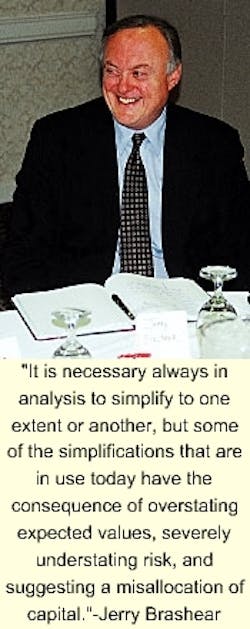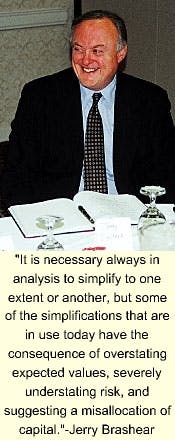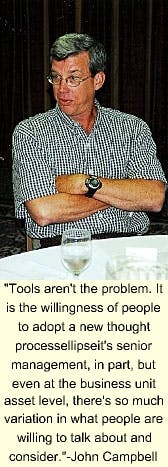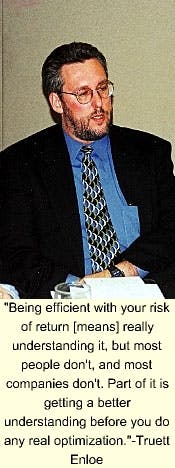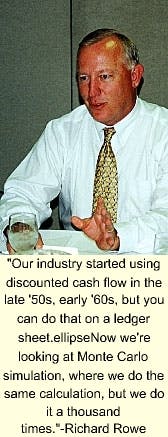Panel: risk-based decision analysis evolving into key tool of E&P sector
The exploration and production business today faces growing pressure to balance high-risk endeavors with outside uncertainties-such as the forever-vacillating prices of oil and gas-all the while making only average rates of return that track well below those of other industries.
As a consequence, E&P managers are left to manage those investment parameters that are within their control-or at least those parameters able to be measured.
Several statistical methods exist to assist in the assessment of physical and financial investment factors in terms of their probabilities for success and for consolidating project evaluations into risk-weighted evaluations of entire portfolios.
The exponential growth in development of computing power and accompanying software programs now makes applications of these calculation-intensive methods practical and economic for a majority of E&P firms.
In theory, the accessibility of these tools will likely improve industry decision-making and, in effect, boost rates of return on capital invested in exploration and production in the near future.
A collection of six industry experts met exclusively with Oil & Gas Journal in a roundtable forum to discuss the ins and outs of these tangible-and measurable-controls and to talk about the developing trends in portfolio and asset management.
The panelists were: Jerry Brashear, managing director, Brashear Group LLC; John Campbell, president, International Risk Management; Truett Enloe, manager, strategic planning, Unocal Corp. unit Spirit Energy 76; Craig Narum, system development director, business management systems, Landmark Graphics Corp.; Richard Rowe, engineering manager, Anadarko Petroleum Corp.; and Michael Walls, associate professor, division of economics and business, Colorado School of Mines.
Industry hurdles
Industry faces four broad classes of barriers with regard to implementing effective risk and portfolio management practices, Brashear noted. These impediments were cited as: lack of support from senior managers; getting the organizational units within a company to work together, or organizational silos; tool inadequacy; and the oversimplification of fundamental problems.
"It is necessary always in analysis to simplify to one extent or another," Brashear explained, "but some of the simplifications that are in use today have the consequence of overstating expected values, severely understating risk, and suggesting a misallocation of capital."
Expanding on these points-which were largely agreed upon by the other panelists-Narum indicated the need for determining the extent to which uncertainty analysis, or lack thereof, and a company's rate of return were linked. "You could make a case that there's a lot of other reasons why [a company's] returns are low, but I think that, as a group, we need to definitively say that there's a link between poor uncertainty analysis and the reason why returns are low."
E&P firms face increased risks on international fronts as well, Rowe added. "One of the significant causes of less-than-stellar returns," Rowe said, "is that the companies that we represent and do business with are-or were at one time-United States-focused. Now we're stepping off into other countries and looking at far more hostile environments. As well as the geologic risk, there is the surface risk, the aboveground risks, and before, those risks had been taken care of rather qualitatively.
"The host countriesellipseare getting very sophisticated, and they're not really interested in having a US company or a company from any other [country] come in and get very wealthy at their expenseellipseand we need to be as sophisticated as well, in order to better understand what the risks and the uncertainties are so that we can structure an agreement with them that's mutually beneficial."
When asked to distinguish between uncertainty and risk, Walls explained that uncertainty is a subset of risk. "You can't have a risky situation without having uncertainty and without having some potential for lossellipsebut you can have uncertainty without having a risky situation, if you are, for instance, not exposed."
"I quote I heard that I liked was, 'Risk is uncertainty that matters,'" Enloe added.
Adoptability
Adoptability, by far, was cited by the roundtable panelists as one of the steeper hurdles for industry to surmount in implementing the newer risk and portfolio analysis tools.
"Tools aren't the problem," said Campbell, "It is the willingness of people to adopt a new thought processellipseit's senior management, in part, but even at the business unit asset level, there's so much variation in what people are willing to talk about and consider."
One of the biggest advances helping management to more easily grasp new technologies and theories, says Campbell, has been through the visualization of what these portfolios look like. Walls agrees. "That's a real key thing, because managers will never use [the new tools] if they think they're black boxes-they'll only use them if they can get some really keen insights from the analysis. And those kinds of visualizations get you those insights that you're looking for," he said.
Ease of use is also helping to raise the adoption rate of such tools, adds Campbell, making them more appealing to E&P managers. "Most of the major companies had programs that did risk assessment and optimization on the mainframe, but they discarded them when they wentellipseto the PC," he said. "Now, with a graphical interface, you can take any educated personellipsethrough the entire process fairly easily and fairly quickly." By combining ease-of-use with visualization characteristics, more and more will accept the technology, he says.
The adoption of these new tools also depends on simple knowledge, Enloe adds. "Being efficient with your risk of return [means] really understanding it, but most people don't, and most companies don't. Part of it is getting a better understanding before you do any real optimization."
Some panelists provided insights into getting managers to consider new risk assessment tools and to 'think differently' overall.
Narum posed this scenario: "If I had two investments, and they both had an expected, deterministic value of $50 million-one investment could range from $40 to 60 million and the other one could be $0-100 million. Would I make a different decision if I knew that information?"
"When we say 'thinking differently,'" said Brashear, "it's not being critical of the people who have obviously been very successful in their careers thinking in the way that they were thinking, but in some ways, it's a way of capturing some of the knowledge that they had and that they applied in a more formal way.
"If you can give them a way of using the information they already know-their knowledge is better utilized-then you can capture that knowledge [and] put it to work for the company. So, in a lot of ways, what these tools do is pull that knowledge that's down inside these very talented people and get it into the analysis and get it built into the decision, not in flashes of insight, but in a systematic, organized way where it can be shared and built upon."
Walls adds: "The dilemma here is that you have senior managers who have been reasonably successfulellipsewho have moved up in the organization and who, perhaps, might be getting close to retirement and have become more risk-averse to taking on new ideas.
"On the other hand, what's pushing against them is the competitive environment that's becoming much more competitive. There are incentives for them to begin to think about new ways of thinking about the world-all they have to do is look at the recent consolidations and it is oftentimes a bit of a wake-up call. It's a question of whether or not that push to really think differently about their decision-making is strong enough to overcome whatever aversion they have to change."
The statistical terminology, suggests Rowe, can be intimidating for some senior managers as well. "As an advocate of the process, it's incumbent upon us to explain it to them in terms that they understand. A person is not a real expert in any subject unless they can explain it to someone else-particularly to the guy who he wants to sell it to-in terms he can understand."
In Brashear's opinion, adoptability is constrained further through the absence of a direct linear connection between the net present value (NPV) maximization risk and those aspects that actually get measured, reported, and later rewarded financially. "You can optimize your portfolio and be right on the optimum, and the next quarterellipsethat fact doesn't come out in the quarterly report. In fact, most quarterly reports don't have anything at all about NPV or very much other than qualitative things about risk.
"So, one of the challenges that has to be resolved by people like us is beginning to drive those things together so that the usual financial metrics are part of the output of this kind of analysis so that there is a tie."
Computing power
Industry has been using tools like Monte Carlo analysis, expected monetary value, portfolio management theory, decision tree modeling, and real options evaluations-to name a few-to make informed decisions about capital allocation and portfolio analysis for a number of years. Increased computer speed has made number-crunching that much faster.
"Our industry started using discounted cash flow in the late '50s, early '60s, but you can do that on a ledger sheet," Rowe said. "ellipseNow we're looking at Monte Carlo simulation, where we do the same calculation, but we do it a thousand times." Brashear adds to Rowe's line of thinking, saying, "No one sat around 25 years ago saying, 'If I only had a bigger computer, I could make all this work.' We worked within the computing capacity we had. I think that we've come a long way because of the computer-I think we're still beginning to invent new ways of working the problem."
Despite the speed at which computing is developing, however, Narum threw out one loose caveat regarding the implementation and use of uncertainty analysis. "Once the value is seen," he said, "one of the things that we need to be a little careful about is that we try to implement it too fast.
"Some companies might think that, once you start doing this, you can have your whole portfolio completely modeled and done in 2-3 months, and then you're ready and on your way. That is going to lead to disaster. Companies have to have the right mindset that this is a 2-3 year journey that involves quality processes, tools, [and] buying and proving the concepts," said Narum.
In addition, notes Enloe, when a new set of tools is implemented, companies often want to use them for everything they do, which can lead to oversimplification of analysis: "[Companies] will learn something new and use the most sophisticated tool on every project-which is clearly overkill-so it takes a little bit of time and some experience to figure out that balance-of which tools to use when."
Risk tolerance
Arriving at a tolerance for risk can be an eye-opening experience, Walls suggests. When asked how a company arrives at its tolerance for risk, he said, "The bad news is [that] most companies don't, in any systematic way, try to arrive at their tolerance for risk-it's just incremental in nature and just unfolds over time based on whatever actions they take. Now, is that good? The answer, from my perspective, is 'no.'
"Just as you and I, personally, like to be certainly consistent about our risk-takingellipsecompanies should, in factellipsetry to be more consistent about their risk-taking. One way they can do that is to actually establish some sort of risk-tolerance level, and there are some companies who have actually looked at that and have tried to actually be more systematic in terms of measuring what their appropriate risk tolerance level is."
There exists certain empirical information, Walls says, that would suggest that there is a relationship between the amount of risk that a company takes and its performance level.
"Those empirical results are pretty consistent with the finance theories, which suggest that if you take a little more risk, on average you're going to get a better return. Companies, oftentimes, can work against them if they're too risk-adverse. If you look at the empirical data over the last 10 years and we look at, coincidentally, ARCO, Amoco Corp., and Mobil Corp.-at least on the E&P side-they were very, very risk-adverse companies. Now, let's see what happened to them?
"It terms of ways to do itellipseit's really a function of what your philosophy is about taking risk-some companies are more aggressive than others, which has a lot to do with their size in an absolute sense-larger companies, on an absolute basis, take more risks than smaller companies-but, relatively speaking, you can take a large independent, which is quite a bit smaller than one of the majors, and they will actually be much more tolerant of risk."
Measuring risk tolerance, in fact, is not easy, Walls says, "But at least once a company measures where they feel comfortable in terms of taking a risk, it gives them the ability to communicate it within the firm."
On the horizon
Some roundtable attendees tried to predict what direction risk and portfolio analysis would take in the near future.
Often, says Brashear, contingencies on longer-range planning and its relationship to risk and portfolio analysis is one subject that gets broached during discussions on the topic.
"It's possible to argue that real planning isn't real until capital is allocated to it, but it is also possible to argue that the direction you start on today determines a fair amount of your opportunity in the future," Brashear noted.
"The issue of contingencies at various scales-certainly within projects and project-to-project-those kinds of interdependencies cross assets where real assets and portfolio analysis really begin to pay off.
"It's true of any kind of portfolio analysis that you can add up the expected value of a group of projects and talk meaningfully about them, because they are averages and means and can be added, but you can't talk meaningfully about how the risks interplay without putting them all together into a portfolio analysis-they are not additive.
"The magic of all this is trying to find ways of increasing expected value while reducing the risk by the interplay and substitution of projects or the recognition of real options. When people talk about embedding real options in portfolios, they're beginning to talk about putting contingency plans at the project level together such that strategy now begins to become something where capital can really be allocated to it-it's not just merely a statement of philosophy or broad direction, but strategic planning and the budget process and long-term contingency planning will become one and the same thing," he said.
Narum suggests that industry should keep moving toward finding a way to integrate technical tools with economic ones on a more dynamic simulation model-such as through earth modeling. "To look at the physics of [technical tools] dynamically linked in a stochastic way to the economic model-subsurface to surface, to different markets, different well schemes, platform schemes-and being able to optimize the entire solution with the technical end of the business would be a big next step," he said.
Brashear noted, "We are beginning to play with aboveground scenario modeling in computational ways that we never did before. Before, we just made up one or two scenarios and said, 'What would happen ifellipse?' Today, we can actually simulate whole markets."
Also, he says, industry would need to solve the problem of placing real options into portfolios, "but we will," he said.
"The computational advances-really in the last 10 years or so-have enabled us to think about the problems in ways we couldn't think about them before, and so the tools are now becoming richer and are beginning to evolve at a pace we've never seen them evolving at before. We're really at the edge of a breakthrough and the community is beginning to respond.
"There is a wave coming; it hasn't broken yet, but it's coming," he said.
The complete transcript of the roundtable is available on line by accessing the free news site at www.ogjonline.com
